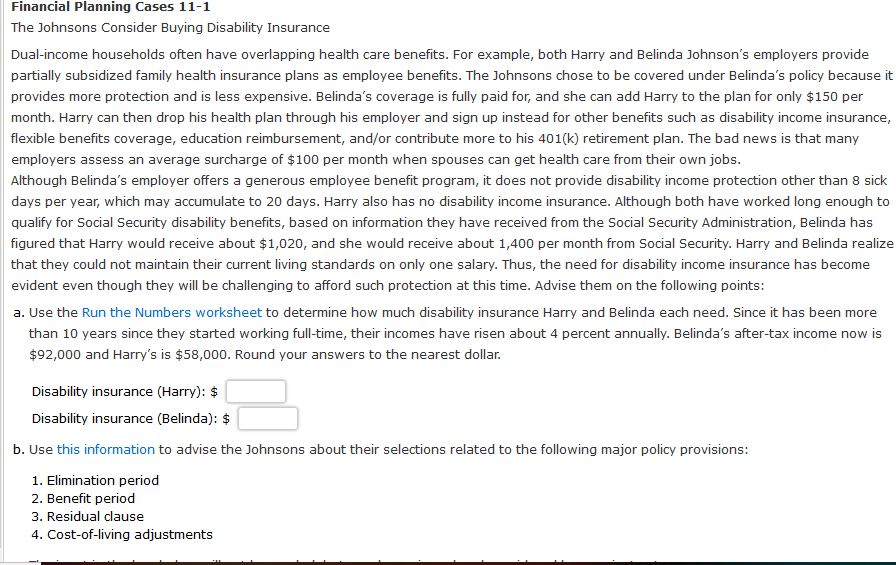
Use the Run the Numbers worksheet to determine how much disability insurance Harry and Belinda each need. Since it has been more than 10 years since they started working full-time, their incomes have risen about 4 percent annually. Belindas after-tax income now is $92,000 and Harrys is $58,000. Round your answers to the nearest dollar.
Use this information to advise the Johnsons about their selections related to the following major policy provisions:
- Elimination period
- Benefit period
- Residual clause
- Cost-of-living adjustments
Financial Planning Cases 11-1 The Johnsons Consider Buying Disability Insurance Dual-income households often have overlapping health care benefits. For example, both Harry and Belinda Johnson's employers provide partially subsidized family health insurance plans as employee benefits. The Johnsons chose to be covered under Belinda's policy because it provides more protection and is less expensive. Belinda's coverage is fully paid for, and she can add Harry to the plan for only $150 per month. Harry can then drop his health plan through his employer and sign up instead for other benefits such as disability income insurance, flexible benefits coverage, education reimbursement, and/or contribute more to his 401(k) retirement plan. The bad news is that many employers assess an average surcharge of $100 per month when spouses can get health care from their own jobs. Although Belinda's employer offers a generous employee benefit program, it does not provide disability income protection other than 8 sick days per year, which may accumulate to 20 days. Harry also has no disability income insurance. Although both have worked long enough to qualify for Social Security disability benefits, based on information they have received from the Social Security Administration, Belinda has figured that Harry would receive about $1,020, and she would receive about 1,400 per month from Social Security. Harry and Belinda realize that they could not maintain their current living standards on only one salary. Thus, the need for disability income insurance has become evident even though they will be challenging to afford such protection at this time. Advise them on the following points: a. Use the Run the Numbers worksheet to determine how much disability insurance Harry and Belinda each need. Since it has been more than 10 years since they started working full-time, their incomes have risen about 4 percent annually. Belinda's after-tax income now is $92,000 and Harry's is $58,000. Round your answers to the nearest dollar. Disability insurance (Harry): $ Disability insurance (Belinda): $ b. Use this information to advise the Johnsons about their selections related to the following major policy provisions: 1. Elimination period 2. Benefit period 3. Residual clause 4. Cost-of-living adjustments Financial Planning Cases 11-1 The Johnsons Consider Buying Disability Insurance Dual-income households often have overlapping health care benefits. For example, both Harry and Belinda Johnson's employers provide partially subsidized family health insurance plans as employee benefits. The Johnsons chose to be covered under Belinda's policy because it provides more protection and is less expensive. Belinda's coverage is fully paid for, and she can add Harry to the plan for only $150 per month. Harry can then drop his health plan through his employer and sign up instead for other benefits such as disability income insurance, flexible benefits coverage, education reimbursement, and/or contribute more to his 401(k) retirement plan. The bad news is that many employers assess an average surcharge of $100 per month when spouses can get health care from their own jobs. Although Belinda's employer offers a generous employee benefit program, it does not provide disability income protection other than 8 sick days per year, which may accumulate to 20 days. Harry also has no disability income insurance. Although both have worked long enough to qualify for Social Security disability benefits, based on information they have received from the Social Security Administration, Belinda has figured that Harry would receive about $1,020, and she would receive about 1,400 per month from Social Security. Harry and Belinda realize that they could not maintain their current living standards on only one salary. Thus, the need for disability income insurance has become evident even though they will be challenging to afford such protection at this time. Advise them on the following points: a. Use the Run the Numbers worksheet to determine how much disability insurance Harry and Belinda each need. Since it has been more than 10 years since they started working full-time, their incomes have risen about 4 percent annually. Belinda's after-tax income now is $92,000 and Harry's is $58,000. Round your answers to the nearest dollar. Disability insurance (Harry): $ Disability insurance (Belinda): $ b. Use this information to advise the Johnsons about their selections related to the following major policy provisions: 1. Elimination period 2. Benefit period 3. Residual clause 4. Cost-of-living adjustments







